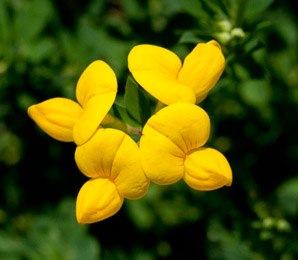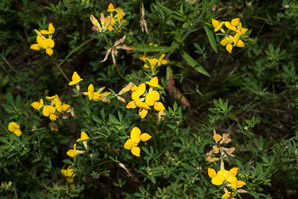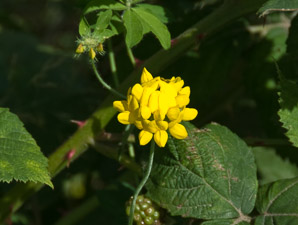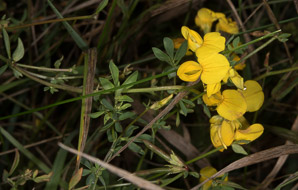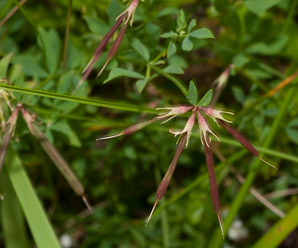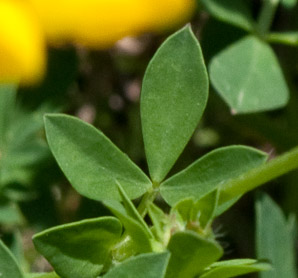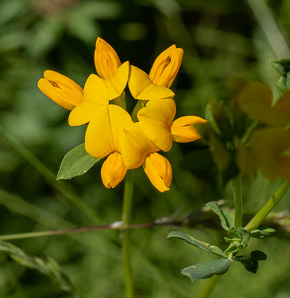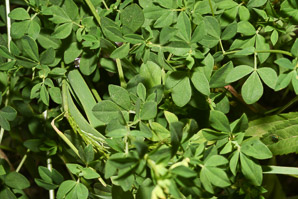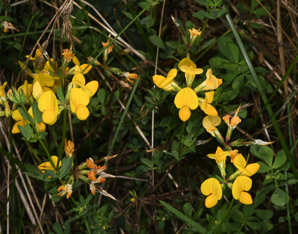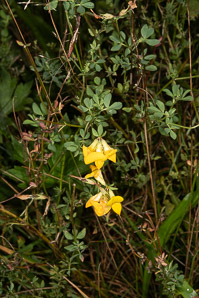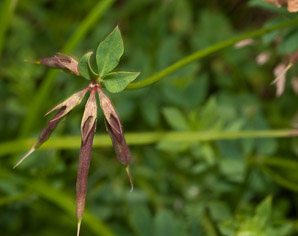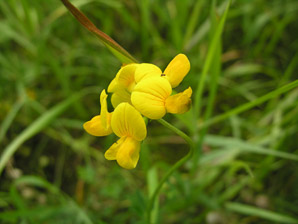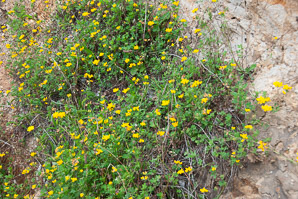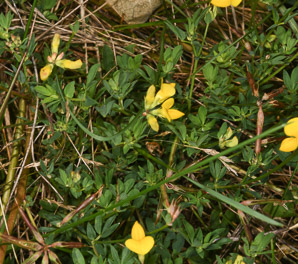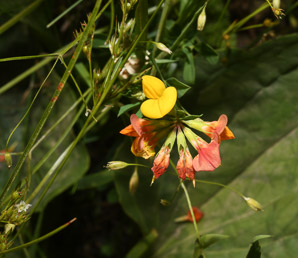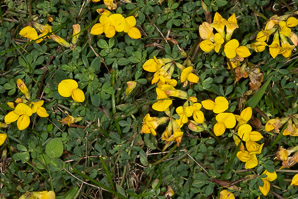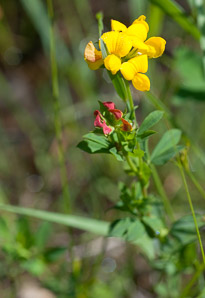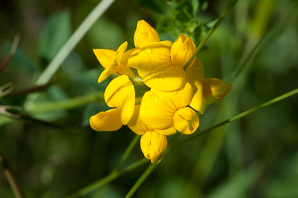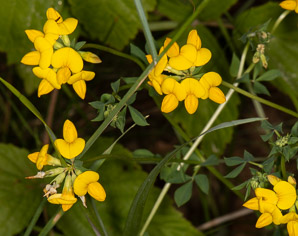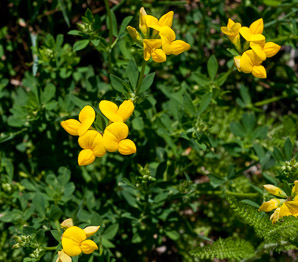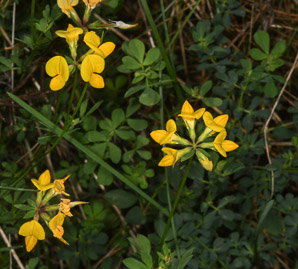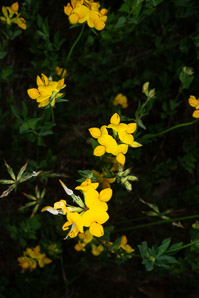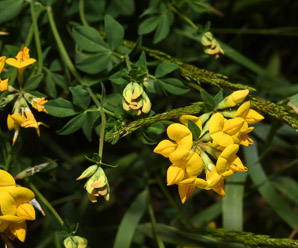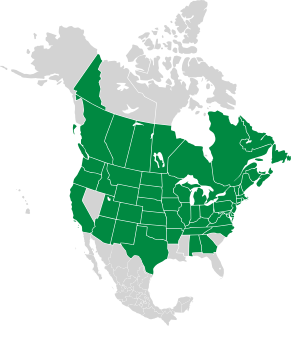
|
Lotus corniculatus L. Bird’s foot trefoil
Bird's foot trefoil is native to the temperate grassland regions of North Africa and Eurasia. They are naturalized in North America, now widespread, and invasive in some areas. The name stems from the fruits, which resemble a bird's foot. Identification: Plants are 6-24″ (15-60 cm) tall. Leaves, pointed ovals in shape, occur in groups of five per petiole. A group of three at the end emerge from the same point, and are ½″ (1.3 cm) × ⅛″ (3.2 mm). The remaining two are lower, smaller, and opposite to each other. Attractive, bright yellow flowers appear in clusters of two to eight. Flowers become more orange in color over time. Each flower is bilaterally symmetrical, composed of 3 upper and 2 lower lobes, about ½″ (1.3 cm) around. Thin red lines are visible on the upper lobe at close quarters. The fruits are shaped like beans, about 1″ (2.5 cm) × ⅛″ (3.2 mm), in small groups. The fruits' long straight shape and emergence from a central point resemble a bird's foot. Fruits are green, maturing to dark red. Like other members of the pea family, these plants trap atmospheric nitrogen, making their own fertilizer, allowing them to colonize soils that other plants cannot. In ultraviolet light, bird's foot trefoil beckons bees (who, unlike us, can see ultraviolet) very differently—bright red, with blue edges! The photo is by Bjørn Rørslett, who has photographed many flowers in UV light. Online References:
Invasive.org, Center for Invasive Species and Ecosystem Health The Connecticut Botanical Society's Connecticut wildflowers site The University of Wisconsin's Robert W. Freckmann Herbarium Plants for a Future, a resource and information centre for edible and otherwise useful plants 6/5/2010 · Nashua River Rail Trail, Groton Center, Groton, Massachusetts · ≈ 4½ × 3″ (11 × 7.9 cm) 8/7/2013 · Amos Kendall Conservation Land, Dunstable, Massachusetts 8/26/2007 · Oregon 9/3/2020 · Mitchell Field, Harpswell, Maine · ≈ 6 × 4″ (15 × 10 cm) 6/27/2012 · Townsend Wildlife Management Area, Townsend, Massachusetts · ≈ 5 × 3½″ (13 × 9.2 cm) 6/5/2010 · Nashua River Rail Trail, Groton Center, Groton, Massachusetts · ≈ 9 × 6″ (22 × 14 cm) 6/22/2023 · Florida Lake Park, Freeport, Maine 6/27/2016 · Nashua River Rail Trail, near Na, Ayer, Massachusetts 8/27/2016 · Williams Barn and Sørhaug Woods, Groton, Massachusetts 9/3/2020 · Mitchell Field, Harpswell, Maine · ≈ 4½ × 7″ (12 × 18 cm)
Lotus corniculatus description by Thomas H. Kent, last updated 11 Jul 2023. © FloraFinder.org. All rights reserved. |
6/27/2012 · Townsend Wildlife Management Area, Townsend, Massachusetts · ≈ 4½ × 3″ (11 × 7.9 cm) 8/4/2006 · Mt. Mansfield, Stowe, Vermont 8/25/2007 · Oswald West State Park, Oregon 8/27/2016 · Williams Barn and Sørhaug Woods, Groton, Massachusetts Flowers redden as they age. · 6/27/2016 · Nashua River Rail Trail, near Na, Ayer, Massachusetts 9/3/2020 · Mitchell Field, Harpswell, Maine · ≈ 6 × 4″ (16 × 11 cm) The closed buds are red. · 6/8/2012 · Townsend Wildlife Management Area, Townsend, Massachusetts · ≈ 4 × 6″ (10 × 15 cm) 6/8/2012 · Townsend Wildlife Management Area, Townsend, Massachusetts · ≈ 4½ × 3″ (11 × 7.9 cm) 6/19/2021 · Long Reach Preserve, Harpswell, Maine · ≈ 6 × 4″ (16 × 10 cm) 6/5/2010 · Nashua River Rail Trail, Groton Center, Groton, Massachusetts · ≈ 7 × 4½″ (17 × 11 cm) 8/27/2016 · Williams Barn and Sørhaug Woods, Groton, Massachusetts 5/30/2015 · Townsend Wildlife Area · ≈ 5 × 8″ (13 × 19 cm) 6/27/2016 · Nashua River Rail Trail, near Na, Ayer, Massachusetts Range:
|
